Ninth Great Deed: The Flood and the Tempter
He got up from this place where he had been sitting in the Eighth Great Deed, and advanced to the Bodhi tree. The term "bodhi" means wisdom, it means "awakened," and it also means "knowledge." How interesting is it that after the Buddha receives the divine Amrita, the water of immortality, from the woman, his Tantric consort, he goes to the Tree of Knowledge (bodhi) and he sits to meditate? Is this not the very tree at the center of the story of the fall of humanity? It was at the Tree of Knowledge that Adam and Eve were tempted and failed: tempted by their own desires, they ate of the fruit, and the ego was born in them.
And out of the ground made the LORD God to grow every tree that is pleasant to the sight, and good for food; the tree of life also in the midst of the garden, and the tree of knowledge of good and evil. - Genesis 2:9
These two trees are intimately related. The Tree of Life is a symbol of the spinal column. The Tree of Knowledge is a symbol of the sexual forces. These two share their roots; the nervous system and the endocrine (sexual) system are intimately related.
The Buddha sits against the Bodhi tree (the Tree of Knowledge), which rises up along his spinal column (the Tree of Life).
And the LORD God commanded the man, saying, Of every tree of the garden thou mayest freely eat:
But of the tree of the knowledge of good and evil, thou shalt not eat of it: for in the day that thou eatest thereof thou shalt surely die. - Genesis 2:16-17
And when the woman saw that the (Bodhi) tree was good for food, and that it was pleasant to the eyes, and a tree to be desired to make one wise (Bodhi), she took of the (sexual) fruit thereof, and did eat, and gave also unto her husband with her; and he did eat.
And the eyes of them both were opened (to their own stupidity), and they knew that they were naked; and they sewed fig leaves together (from the Tree of Knowledge), and made themselves aprons (to cover their sexual crime).
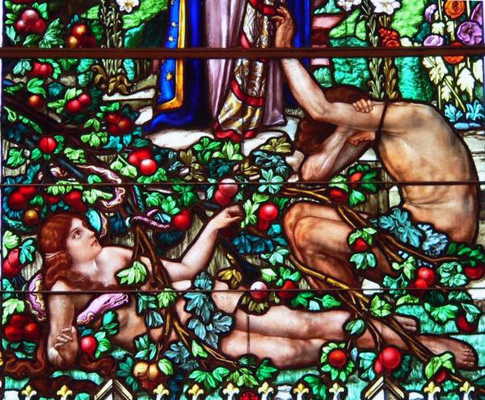
And they heard the voice of the LORD God walking in the garden in the cool of the day: and Adam and his wife hid themselves from the presence of the LORD God amongst the trees of the garden.
And the LORD God called unto Adam, and said unto him, Where art thou?
And he said, I heard thy voice in the garden, and I was afraid (the ego is now alive), because I was naked; and I hid myself. - Genesis 3:6-10
For Shakyamuni to advance towards liberation, he has to return to the origin of suffering: the Bodhi tree, the Tree of Knowledge: sex.
But do you know what kind of tree it is? The Bodhi tree is a kind of a ficus: a fig tree. In the Bible, the fig tree is very important. Do not Adam and Eve cover their sexual organs with a fig leaf ?
And the eyes of them both were opened, and they knew that they were naked; and they sewed fig leaves together, and made themselves aprons. - Genesis 3:7
The fig tree is related to sexuality, but specifically to feminine sexual forces, the forces of Neshamah, the forces of Buddhi, Geburah, our divine consciousness.
When the Buddha Shakyamuni sat at the Bodhi tree, the tree of wisdom, the Tree of Knowledge, he harnessed the forces of the Amrita, the milk, and transmuted those forces to enliven his spinal column), the Tree of Life.
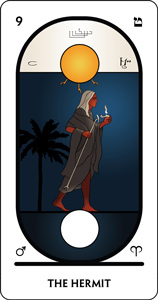 The Arcanum Nine is illustrated by a lone hermit in the wilderness; behind him is a palm tree, the symbol of victory. The hermit raises his lamp of wisdom to illuminate the darkness. We raise our lamp by awakening the consciousness and by working with the Amrita, the waters of the Ninth Sphere: the sexual waters of Yesod, the ninth sephirah of the Kabbalah, that relates to the sexual organs.
The Arcanum Nine is illustrated by a lone hermit in the wilderness; behind him is a palm tree, the symbol of victory. The hermit raises his lamp of wisdom to illuminate the darkness. We raise our lamp by awakening the consciousness and by working with the Amrita, the waters of the Ninth Sphere: the sexual waters of Yesod, the ninth sephirah of the Kabbalah, that relates to the sexual organs.
The Buddha stayed in meditation at the base of this tree for 49 days. Why? Why 49? 49 days, in the eastern traditions, is symbolic. When someone dies, there is always a period of mourning for 49 days, a period of observance, a period of remembrance, a period of prayer, to honor that person and to assist them as they move on to their new life. When the Buddha Shakyamuni sat for 49 days at the base of the tree, this is symbolic of the approaching death, psychological death, the death of the mind, the full and complete and total death of everything that is subjective and illusory within himself. In other words, he will take the waters of the Amrita, that milk, and transform that into fire, and light the 49 fires of the mind. And these 49 fires are related to the seven bodies and the seven chakras in each body.
It is said that after four weeks of meditating at the Bodhi tree, he was so concentrated, so focused, that he did not realize or care that a great storm was brewing around him. The storm symbolizes a karmic, initiatic ordeal; in a dream or religious story, a storm represents an ordeal, challenges, sufferings, difficulties, with all the qualities of any storm in nature.
A flood began to creep up around Shakyamuni. So, his life was in danger. But a great king of the elemental kingdom came to assist him. This king is named Mucalinda, and he is a Naga king.
A Naga is a serpent, and in the east, in Asia, it is known that there is a race of beings called the Nagas (Tibetan: Lu). Nagas are related to elemental forces who protect bodies of water, like rivers, lakes, streams, and it is well-known that any person who approaches a lake, a stream, or a pond should always treat it with respect, otherwise the Nagas will take revenge. As an example, if a person goes to any pond, lake, or stream to relieve themselves of urine or any other bodily function, they will become sick. And it is because the Nagas want to teach that person to respect the water, to not pollute the water. This is a folk tradition in India, and in other countries in that region.
Mucalinda recognized that the Buddha was in danger, so the Naga King Mucalinda manifested himself in his serpent form, coiled himself under the Buddha, and raised the Buddha up above the rising flood waters at the base of the tree. Mucalinda also raised himself over the Buddha and manifests himself with seven heads to act as a shield or an umbrella to protect Buddha from the rain.
You know, of course, that the flood is very important in the Greek mysteries, because Zeus sent a flood to destroy the impure humanity. And the flood is also very important in the Babylonian and Assyrian mysteries, because of the same reason. And the flood is important in the Jewish tradition, because of the same reason. Likewise in the Christian. The Universal Flood appears in countless mythologies, both as a record of past events and as a symbol from the esoteric mysteries.
In the life of the initiate, the flood comes as a process of the death of the I. The flood waters are those waters of passion, the sexual waters, which rise up because of transmutation. And those waters are churned, and are in activity, because of all the energy, because of all the karma of that initiate. Many drown, because they become identified with their own passions, their own karma, their own idiocies, and they fail. But the Buddha remained in meditation and received the assistance of the elemental forces, Mucalinda, who in this context represents the Divine Mother Kundalini, which is coiled three and a half times at the base of the spine in the Muladhara chakra. By working with a spouse, the initiate awakens that sacred fire and the serpent of the Kundalini begins to rise up the spine in order to shield the initiate and protect him from pain. In dream symbolism, rain indicates painful karma that is due. The initiate who raises the serpent of the Kundalini receives protection from the pain of karmic debts. He must still pay, but with meditation and transmutation, the pain becomes bearable.
Mucalinda manifests with seven serpent heads. This is related to the statement of the Buddha, "Listen to me well, Gods and humans, for within each Buddha are seven Buddhas." These seven Buddhas are the seven bodies of the soul, the seven bodies which make up the physiology of the vehicle through which the Buddha can express. We are not using the term soul in the traditional term, which Buddhism refutes; this is a different term, more like "body." Those seven serpent heads represent how the Kundalini must be raised in all of these seven aspects of our physiology and psychology.
When those seven serpents are raised, the serpent or the Kundalini is raised upon the spine seven times, then the forty-nine fires are lit, the forty-nine symbolic days are complete.
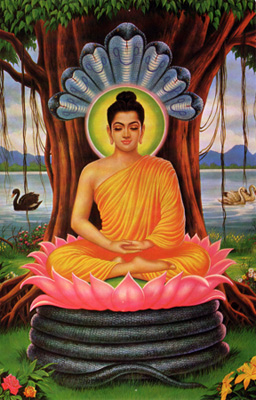
The storm passed, and then Mara appeared. Mara is a Sanskrit word or Pali word, which means "destruction," it can also mean "murder." It is interesting, because in Hebrew, Mara means "bitterness." Mara came to taunt the Buddha, to make fun of him, to question the Buddha's actions, in the same way that Lucifer tempted Jesus in the wilderness, tempting him with powers, tempting him to show himself, tempting him with wealth. So, Mara is the dragon of darkness, Lucifer, the tempter. Mara is part of the Buddha. Mara represents our own mind, all of the egotistical desires within our own mind, which always tempt us away from the right path, from right action.
The Buddha is focused on his meditation and on transforming the flood waters - the waters of sexual passion - into pure Amrita; this threatens Mara's power. Mara has the power to utilize desire and sensation in order to hypnotize humanity. And truly, most of humanity is completely under Mara's power: everyone is hypnotized by sexual sensation, and have no will power to control their own sexual waters.
But Shakyamuni is different. So, Mara tried many approaches in order to break Shakyamuni's meditation. Mara sent his armies, demons, against the Buddha, and they fired their weapons; the arrows approached the Buddha and were transformed into flowers. And when they threw their magical spells against the Buddha, and stones and fire and water and wind, they were all transformed into flowers and beautiful fragrances. Why? In Gnosis we call this the transformation of impressions. This is the capacity that an initiate has to cultivate, to develop, through meditation, through self-observation, through self-remembering, by being awake, by paying attention, by learning how to utilize the consciousness, the Buddha-nature, to perceive the inherent truth of any given phenomena. In other words, when the demons (the ego, the karma) throw painful elements (the arrows, the fire, the wind, the ordeals of life, criticism, blame, poverty, suffering, wealth...) the initiate has to learn how to transform those impressions consciously, to take those harmful elements and comprehend them.
Ordeals are inevitable, because we have karma. When we undertake the work to clean ourselves of karma, we have to face all the causes that are within us: those causes are revealed when the ordeals are thrown at us. These ordeals are related to the four elements of nature. To transform them, to take advantage of them, requires that receive them consciously, with serenity.
This is a work of conscious attention, comprehension. It can't be faked, it cannot be emulated, it cannot be mimicked; you either do it, or you don't. The Buddha in this story, in this symbol, shows us how we have to develop the capacity to receive all the impressions of life with receptive, serene consciousness that can perceive the essential reality of any given impression.
For example, if someone criticizes us (throwing arrows, related to the element of fire, because criticism burns), and we receive those words with equanimity - without pride or vanity - then those arrows find no target. If there is no ego in the way, no one to be hurt by the criticism, then what is there? Humility, tenderness, compassion: then those arrows become flowers for the consciousness, virtues of the consciousness. But this transformation cannot be faked. Only an awakened, receptive consciousness can transform impressions.
If someone gossips about us, how do we react? If our pride or vanity reacts, we will be hurt. But if we are not identified with our pride or vanity, then there is no one who can be hurt. This requires meditation, because our ego, our mind in its current state, cannot do it. Our ego, our mind now, is Mara, and the demons of Mara. Our Buddha-nature has the essential faculty to transform impressions, but we have to grow it through meditation.
All initiation is a process of conquering temptation through serene comprehension. Arcanum Nine is the arcanum of initiation.
One interesting version of the story relates that the demons of Mara are conquered when the earth goddess wrings out her hair, creating a flood of waters that drown all the demons. In the Judeo-Christian tradition, long hair is the symbol of chastity (i.e. Samson). The power of the sexual waters is in chastity, and is delivered by the grace of the Divine Mother.
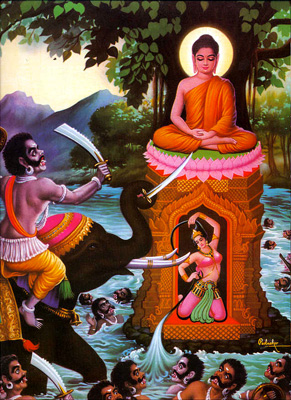
The feminine sexual forces (ida, eve) are the power that we lost in the garden of Eden. By meditating under the Bodhi tree (the fig tree of sexual knowledge) the Buddha recovers the powers that Buddhi (Neshamah) brings; it is this power that can conquer the ego.
When the demons and all their attacks were proving to be useless, Mara sent his three beautiful daughters to tempt the Buddha. These three daughters, in the Buddhist tradition, are assigned many different meanings. Sometimes there are also represented as three sons. The basic meaning is the same. These are the Three Furies of Greek mythology, the Three Traitors of Osiris (Egyptian), the Three Traitors of Hiram Abiff (Freemasonry), the Three Traitors of Moses (Hebrew/Christian), of Job, the Three Traitors of Jesus, the Three Traitors of Caesar, and the Three Traitors that Dante sees in the ninth level of hell, the ninth circle.
These three daughters of Mara did what they could to tempt the Buddha. But how?
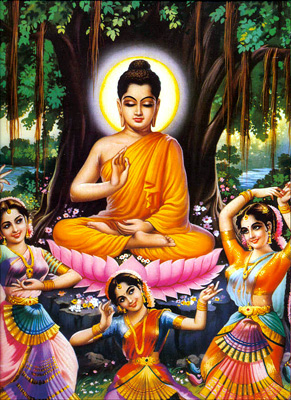
In the Buddhist tradition, the three daughters are sometimes they are interpreted as symbols of the three times: past, present, and future. Sometimes they are called desire, fulfillment, and regret. But in synthesis, we can relate them to our three brains: intellect, emotion, and motor-instinctive-sexual. It is through these three psychological aspects that we are tempted by our own desires. We are tempted through reasoning (intellectual brain), we are tempted through emotion, and we are tempted by sensation (motor-instinctive-sexual brain).
Lucifer tempted Jesus three times in the desert. But through it all, Jesus remembered himself.
Of course, the Buddha remained firm in his meditation, controlling his awareness, conscious of himself, and he therefore he conquered the three daughters of Mara. How? By not becoming identified with any desire, in any of the three aspects of his own mind. No thought could make him forget himself, no emotion, and no sensation. No temptation could overcome him. For this to happen, the ego must be dead. But to overcome desire is a great work. No one can do this overnight.
Seeing that his daughters failed to tempt Shakyamuni, Mara taunted him and said, "What gives you the right, how is it that you have the audacity, the pride to think that you can overcome me?"
The Buddha said, "Listen well, I have not done this only now. I am able to conquer you now, at this moment, because I have been working for this moment for uncounted ages, in all my lives. This is not something that occurs spontaneously."
Mara said, "Who do you have as a witness of that? You could be lying to me."
The Buddha very serenely pointed to the earth and touched the earth with his fingers. Out of the Earth emerged the Goddess, the Divine Mother, and she said, "I give witness of his Truth." So Mara has no choice but to withdraw, conquered.
Where would the Buddha be without his Divine Mother? At every turn, She is the source of his liberation.
Every Buddha is born of chaste sexuality and the grace of the Divine Mother.
Every Buddha has a mother and a father. Every Buddha is a child of pure, chaste sex.
Through profound meditation with awakened consciousness, Shakyamuni conquered his own sexual passion (the flood), withstood the karmic consequences of his past actions (the rain), raised the seven serpents (the Naga King), transformed all the negativity of his own ego (Mara and the demons), and remained serene in the presence of subtle temptations (the three daughters). As a result, from the rich, dry earth under him emerged the essence of the Goddess, to witness his triumph. This symbolizes that the Buddha has his foundation in the Divine Mother, in that primordial wisdom that gives rise to all existence. His mind now stable and on a firm foundation, he is now ready to go deeper into his comprehension of reality.
